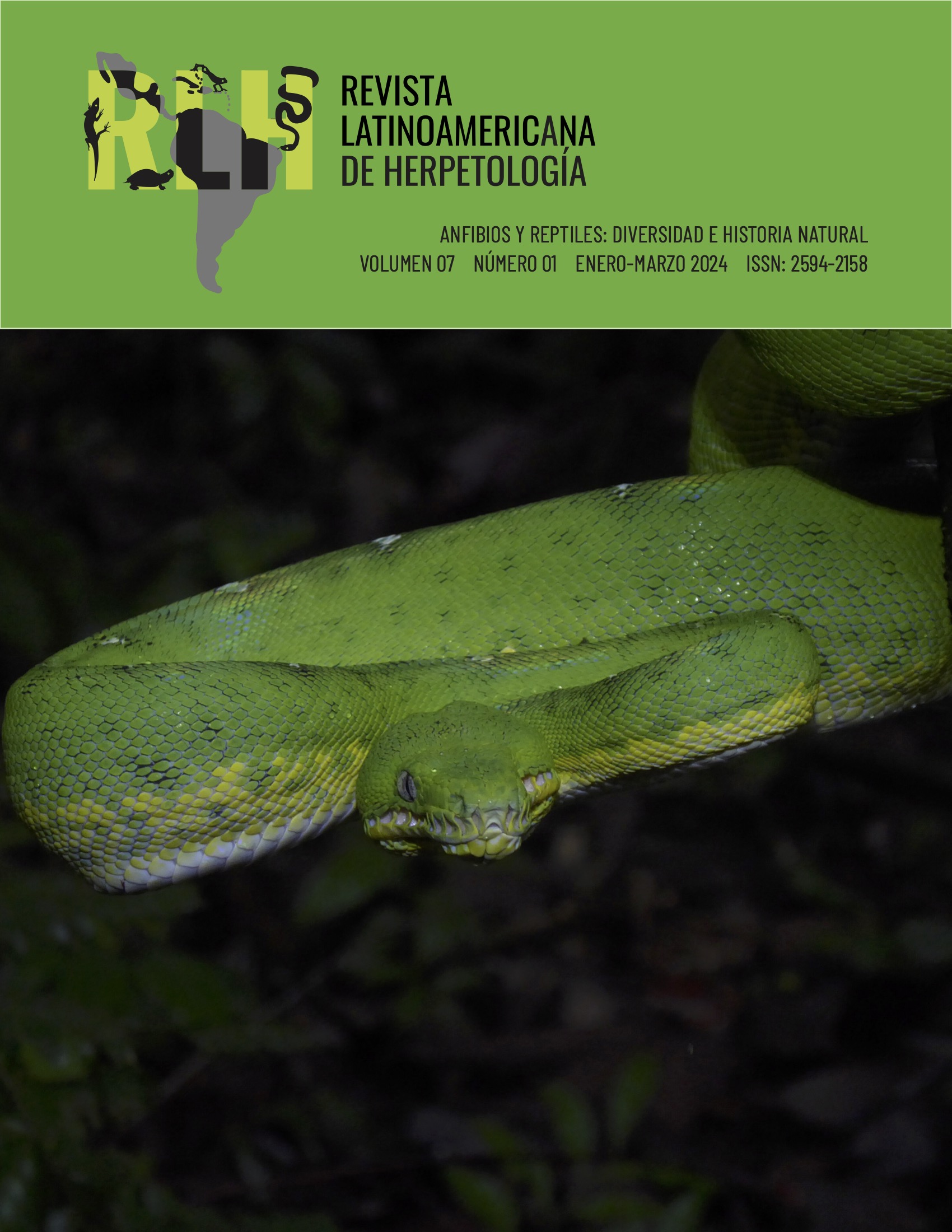FIRST RECORD OF THE MEXICAN CAECILIAN, Dermophis mexicanus (DERMOPHIIDAE), IN COSTA RICA
DOI:
https://doi.org/10.22201/fc.25942158e.2024.1.829Keywords:
Dermophis mexicanus, Nicoya Peninsula, distribution, Tropical Dry Forest, biodiversity.Abstract
This note provides the first record of the Mexican caecilian (Dermophis mexicanus) in Costa Rica. The known distribution of this species covered from southeastern Mexico to central Nicaragua. The morphological and genetic review of an individual found in Cóbano, Puntarenas, on the Nicoya Peninsula confirms its presence in Costa Rica and increases the distribution of the species 260 km to the south.
References
AmphibiaWeb. 2023. AmphibiaWeb: Information on Amphibian Biology and Conservation [web application]. https://amphibiaweb.org/cgi/amphib_query?where-scientific_name=Dermophis&rel-scientific_name=contains&include_synonymies=Yes Berkeley, California. [Consulted in 23 September 2023]
Arias, E & B. Kubicki. 2018. A new moss salamander, genus Nototriton (Caudata: Plethodontidae), from the Cordillera de Talamanca, in the Costa Rica-Panama border region. Zootaxa 4369:487-500.
Arias, E., A. Hertz & G. Parra-Olea. 2019. Taxonomic assessment of Craugastor podiciferus (Anura: Craugastoridae) in lower Central America with the description of two new species. Amphibian & Reptile Conservation 13:173-197.
Frost, D.R. 2023. Amphibian Species of the World: An Online Reference. Version 6.1. https://amphibiansoftheworld.amnh.org/Amphibia/Gymnophiona/Dermophiidae/Dermophis. American Museum of Natural History, New York, USA. [Consulted in 23 September 2023]
Hilje, L, R.F. Arias, B. Hilje, & W. Solórzano. 2022. Santa Rosa, Paraje de Diversidad y Escenario de Libertad. Editorial UTM. San José, Costa Rica.
Holdridge, L.R. 1967. Life Zone Ecology. Tropical Science Center, San José, Costa Rica, 206 pp.
IUCN SSC Amphibian Specialist Group. 2020. Dermophis mexicanus. https://www.iucnredlist.org/species/59545/53988419 The IUCN Red List of Threatened Species 2020: e.T59545A53988419. [Consulted in 13 September 2023]
Kubicki, B. & E. Arias. 2017. Vulcan’s slender caecilian, Caecilia volcani, Costa Rica. Mesoamerican Herpetology 4:488-492.
Miller M.A., W. Pfeiffer & T. Schwartz. 2010. Creating the CIPRES Science Gateway for inference of large phylogenetic trees. Proceedings of the Gateway Computing Environments Workshop November 2010:1-8.
Moritz, C., C.J. Schneider & D.B. Wake. 1992. Evolutionary relationships within the Ensatina eschscholtzii complex confirm the ring species interpretation. Systematic Biology 41:273-291.
Palumbi, S., A. Martin, S. Romano, W.O. McMillan, L. Stice & G. Grabowski. 1991. The simple fool’s guide to PCR, version 2.0. Special Publication, Department of Zoology and Kewalo Marine Laboratory, University of Hawaii, Honolulu, Hawaii, USA.
Ronquist, F., M. Teslenko, P. Van Der Mark, D.L. Ayres, A. Darling, S. Höhna, B. Larget, L. Liu, M. Suchard & J.P. Huelsenbeck. 2012. MrBayes 3.2: efficient Bayesian phylogenetic inference and model choice across a large model space. Systematic Biology 61:539-542.
Savage J.M. 2002. The Amphibians and Reptiles of Costa Rica. A Herpetofauna Between Two Continents, Between Two Seas. The University of Chicago Press, Chicago, Illinois, USA.
Savage J.M. & M.H. Wake. 2001. Reevaluation of the status of taxa of Central American caecilians (Amphibia: Gymnophiona), with comments on their origin and evolution. Copeia 2001:52-64.
Sunyer, J. 2009. Taxonomy, zoogeography, and conservation of the herpetofauna of Nicaragua. Department of Biology, Goethe University, Frankfurt am Main, Germany.
Wilkinson, M., D. San Mauro, E. Sherratt, & D.J. Gower. 2011. A nine-family classification of caecilians (Amphibia: Gymnophiona). Zootaxa 2874:41-64.
Zwickl, D.J. 2006. Genetic algorithm approaches for the phylogenetic analysis of large biological sequence datasets under the maximum likelihood criterion. Ph.D. Dissertation, The University of Texas, Austin, Texas, USA. 125 p.
Downloads
Published
How to Cite
Issue
Section
License
Copyright (c) 2024 Revista Latinoamericana de Herpetología

This work is licensed under a Creative Commons Attribution-NonCommercial-ShareAlike 4.0 International License.







